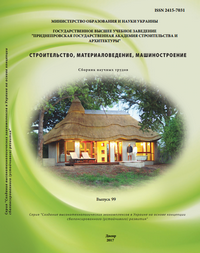The main insulation parameters for the design of nzeb from biosourced materials
Keywords:
energy-efficiency, sustainable development, nearly zero energy building.Abstract
Abstract: Purpose of the presented research is to define the parameters for insulation envelope for NZEB. The study subjects related to designing of NZEB. This article focuses on the comparison of requirements in normative documents of different countries. Based on the results of this comparison and the information of the heat losses of building, the main parameters of insulation design of biosoursed materials are determined. In addition, the influence of these parameters on the building envelope were investigated. Methodology. We used the estimation of the annual heat losses that is presented in national normative documents [18,19]. Findings. The results of calculating of the necessary insulation based on organic materials for a passive building were obtained. As well, it was established that the conditions of the materials application plays an important role in the using of the biosourced insulation materials. Originality. Analysis of factors affecting heat losses in the building has been realized. Determination of the main parameters for the design of NZEB of local biosourced materials have been received. Practical value. The article presents data that can be used for designing the insulation thickness, depending on the used biosources material and the element of insolation envelope.References
The BOLIG+ project, http://www.boligplus.org/(in Danish).
V. Åkarp, http://greenlineblog.com/2009/02/villa-karp-a-positive-net-energyhouse-in-malm-sweden/.
The International Energy Agency (IEA) Net Zero Energy Buildings Database, http://iea40.buildinggreen.com/index.cfm.
M. Noguchi, A. Athienitis, V. Delisle, J. Ayoub, B. Berneche, Net Zero Energy Homes of the Future: A Case Study of the ÉcoTerraTM House in Canada, in: Renewable Energy Congress, Glasgow, Scotland, July, 2008.
The Active House project, http://www.activehouse.info/ (accssed 19.04.17).
M. Heinze, K. Voss, Goal zero energy building – exemplary experience based on the solar estate Solarsiedlung Freiburg am Schlierberg, Germany, Journal of Green Building 4 (4) (2009).
E. Musall, T. Weiss, A. Lenoir, K. Voss, F. Garde, M. Donn, Net Zero Energy Solar Buildings: An Overview and Analysis on Worldwide Building Projects, in: EuroSun Conference 2010, Graz, Austria, 2010 (under review).
The IEA SHC Task 40/ECBCS Annex 52 ‘Towards Net Zero Energy Solar Buildings (NZEBs)’, http://www.ieashc.org/task40/index.html.
The Strategic Research Centre on Zero Energy Buildings, http://www.zeb.aau.dk/.
The Research Centre on Zero Emission Buildings (ZEB), www.zeb.no.
Zero Carbon Hub, http://www.zerocarbonhub.org/.
D. Crawley, S. Pless, P. Torcellini, Getting to net zero, ASHRAE Journal 51 (9) (2009) 18–25.
I. Sartori, A. Napolitano, K. Voss, Net Zero Energy Buildings: A Consistent Definition Framework, Energy and Buildings 48 (2012) 220–232.
P. Hernandez, P. Kenny, From Near Energy to Zero Energy Buildings: Defining Life Cycle Zero Energy Buildings (LC-ZEB), Energy and Buildings 42 (2010) 815–821.
A.J. Marszal, P. Heiselberg, J.S. Bourrelle, E. Musall, K. Voss, I. Sartori, A. Napolitano, Zero Energy Building – A Review of Definitions and Calculation Methodologies, Energy and Buildings 43 (2011) 971–979.
Ajla Aksamijaa, Regenerative Design of Existing Buildings for Net-Zero Energy Use, Procedia Engineering 118 (2015) pp. 72 – 80.
Comparative study of the lightweight concretes on the base of hemp and flax straw/ Maryna Babenko, Adriana Estokova, Mykola Savytskyi, Kateryna Sobinova// Selected Scientific Papers - Journal of Civil Engineering-TUKE – review process
Настанова з розроблення та складання енергетичного паспорта будинків при новому будівництві та реконструкції: ДСТУ НБА. 2.2-5: 2007. - [Чинний від 2007—07—01]. - К.: Мінрегіодбуд України, 2007 – С. 5-11- (Національний стандарт України). DSTU-N.B.A.2.2-5:2007 Proektuvannya. Nastanova z rozroblennya energetichnogo pasporta budinkiv budivel [State Standard B.A.2.25:2007. Designing. Order on development and drafting the energy passport of a building for new building and reconstruction], Kyiv, Minregionbud, Ukraine Publ., 2008. 43 p.
Конструкції будинків і споруд. Теплова ізоляція будівель: ДБН В.2.6.- 31: 2006. - [Чинний від 2007-04-01].- К: Мінбуд України , 2007. - (Національний стандарт України). DBN V.2.6-31:2006 Konstruktsiyi budivel i sporud. Teplova Izolyatsiya budivel [State Building Codes V.2.6–31:2006. Construction of buildings and structures. Thermal insulation of buildings], Kyiv, Minbud, Ukraine Publ., 2006. 68 p [20] Energy Performance of Buildings Directive (EPBD) (2009).
Downloads
Published
Issue
Section
License
Редакція Видання категорично засуджує прояви плагіату в статтях та вживає всіх можливих заходів для його недопущення. Плагіат розглядається як форма порушення авторських прав і наукової етики.
При виявлені у статті більш ніж 25% запозиченого тексту без відповідних посилань та використання лапок, стаття кваліфікується як така, що містить плагіат. У цьому випадку стаття більше не розглядається редакцією, а автор отримує перше попередження.
Автори, в статтях яких повторно виявлено плагіат, не зможуть публікуватися в усіх журналах Видавництва ДВНЗ «Придніпровська державна академія будівництва та архітектури».
Автори, які публікуються у цьому журналі, погоджуються з наступними умовами:
- Автори залишають за собою право на авторство своєї роботи та передають журналу право першої публікації цієї роботи на умовах ліцензії Creative Commons Attribution License, котра дозволяє іншим особам вільно розповсюджувати опубліковану роботу з обов'язковим посиланням на авторів оригінальної роботи та першу публікацію роботи у цьому журналі.
- Автори мають право укладати самостійні додаткові угоди щодо неексклюзивного розповсюдження роботи у тому вигляді, в якому вона була опублікована цим журналом (наприклад, розміщувати роботу в електронному сховищі установи або публікувати у складі монографії), за умови збереження посилання на першу публікацію роботи у цьому журналі.
- Політика журналу дозволяє і заохочує розміщення авторами в мережі Інтернет (наприклад, у сховищах установ або на особистих веб-сайтах) рукопису роботи, як до подання цього рукопису до редакції, так і під час його редакційного опрацювання, оскільки це сприяє виникненню продуктивної наукової дискусії та позитивно позначається на оперативності та динаміці цитування опублікованої роботи (див. The Effect of Open Access).

